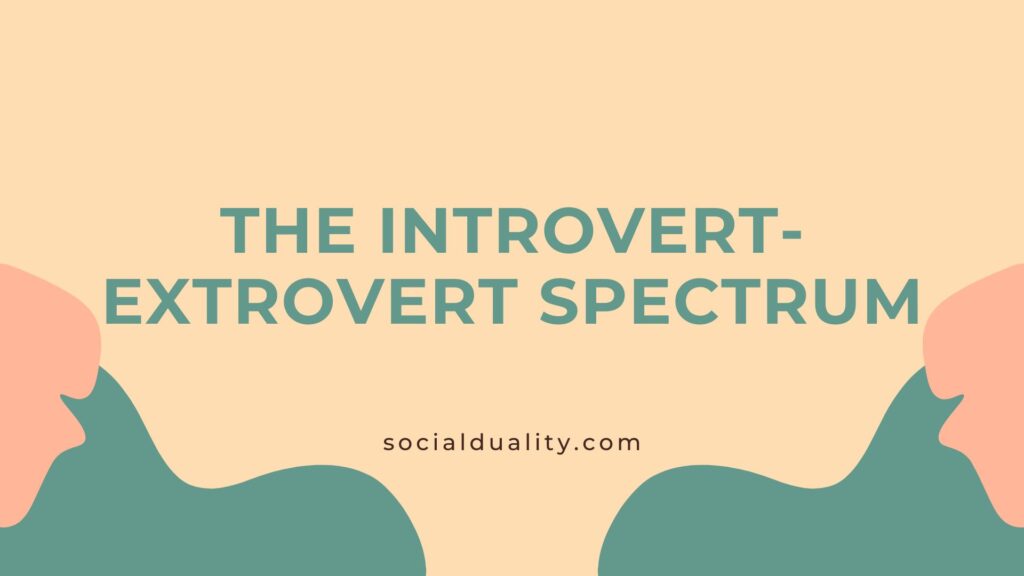Ever wonder where you fit on the introvert-extrovert spectrum? It’s not just about preferring books over parties or the other way around. This spectrum shows the colorful blend of human personality, emphasizing that most of us share traits of both introverts and extroverts. Think of it as your social battery; introverts may find their energy depleting in crowds, needing solitude to recharge. Meanwhile, extroverts get a buzz from lively gatherings, feeling drained when alone too long.
The concept dives deep into personality traits, revealing how our brains—whether craving quiet reflection or seeking the thrill of company—navigate life’s situations. It’s fascinating how social psychology and neuroscience intertwine, highlighting individual differences and how we process the world around us. Whether you thrive in solitude or in the company of others, understanding this spectrum can lead to better social interactions and even enhance extrovert relationships.
Incorporating positive psychology exercises tailored to your spot on the spectrum can significantly improve well-being, emphasizing the beauty in embracing individual differences. So, whether you’re delving into the quiet depths of introversion or exploring the vibrant energy of extroversion, there’s a unique power in recognizing where you shine.
Key Takeaways
Ever asked yourself if you’re more of an introvert or an extrovert? It’s a common question, but the answer is not always black and white. You might find yourself somewhere in the middle of the introversion-extroversion spectrum. This concept goes beyond simple labels, offering a more nuanced view of where our personalities lie.
- Introverts recharge by spending time alone, enjoying deep, introspective thoughts. They might not be the life of the party, but they shine in creative and analytical tasks.
- Extroverts, on the other hand, thrive on social interactions. They love being in the mix, meeting new people, and engaging in conversations.
- Ambiverts balance introverted and extroverted traits, adapting their behavior to suit different life situations.
- Understanding the introvert-extrovert spectrum can improve social interactions and even boost extrovert relationships.
- Incorporating positive psychology exercises can help both introverts and extroverts enhance their well-being.
This blend of human personality traits suggests that embracing individual differences is key to navigating not just personal relationships but professional environments as well. Whether in quiet reflection or lively discussions, knowing where you stand on the spectrum can unlock a deeper understanding of yourself and how you interact with the world around you.


Defining Introverts and Extroverts
When exploring the spectrum of introversion and extroversion, it’s crucial to recognize the variety of personality traits that influence how we recharge and connect. Introverts often enjoy solitude, using quiet time for reflection, while extroverts draw energy from being around others. The intersection where these traits meet introduces the term ambivert, those who fluidly adapt to social situations with ease. In my piece on the science behind introversion and extroversion, I delve deeper into how these dynamics affect our lives and relationships, underscoring the importance of understanding where we fall on this continuum for personal growth.
Characteristics of Introverted Individuals
Traits of people who identify more with introversion shine through in their love for solitude and deep, thoughtful activities. They might find large parties draining, preferring instead a quiet evening with a book or a close friend. This doesn’t mean they’re shy; they simply process the world differently, cherishing internal reflections over external stimuli. Introverts bring critical thinking and creativity to the table, skills that are invaluable in both personal and professional settings. Their ability to dive deep into subjects makes them excellent problem-solvers. For those balancing both introverted and extroverted traits, our discussion on navigating communication styles offers further insight.
Characteristics of Extroverted Individuals
Traits distinguishing those with a penchant for extroversion illuminate a spectrum of engaging, outward-focused behaviors. Energized by social interaction, they gravitate towards group activities, feeling an uplift in spirited environments. Unlike their introverted counterparts who seek solace in solitude, these individuals flourish amidst the hustle and bustle, often being the life of the party. Their comfort in expressing themselves makes for effortless communication, fostering connections with ease. This knack for networking isn’t just social—it’s a key asset in collaborative settings, where their propensity for teamwork shines. Reflecting on the introvert-extrovert spectrum, it’s clear that understanding one’s position can significantly enhance interpersonal dynamics and self-awareness.
Understanding the Introvert-Extrovert Spectrum
Diving into the concept of the introversion-extroversion spectrum, we uncover a dynamic range where introverts and extroverts are just the start. Picture a slider, not a switch, with room for everyone in between. Here enters the term ambivert, a middle ground that might sound like a superpower in today’s world. It’s about adapting effortlessly to various life situations, whether that calls for reflection or revelry. Imagine mastering this flexibility; you’re neither drained from too much party nor too much peace. It’s the sweet spot for those who find energy both in solitude and the crowd, making the most of every social and solo scenario.


The Ambivert: A Balance Between Extroversion and Introversion
Navigating the middle ground between extroversion and introversion reveals the vibrant landscape of ambiverts. These individuals harness the power to adjust their approach based on the setting, embodying a mix of reflective and social strengths. It’s this ability to oscillate between energy sources that marks them as uniquely adaptable, thriving in both quiet contemplation and lively gatherings. Their versatility highlights the importance of the spectrum, encouraging a deeper appreciation for the varied nuances within human personality.
| Trait | Introverts | Ambiverts | Extroverts |
|---|---|---|---|
| Energy Source | Solitude | Context-Dependent | Social Interaction |
| Preference | Quiet Reflection | Balance | Group Activities |
| Strengths | Deep Thinking | Adaptability | Networking |
| Social Needs | Low | Moderate | High |
| Ideal Environment | Peaceful | Flexible | Stimulating |
Neuroscience Behind Introversion and Extroversion
Delving into the neurological foundation of introversion and extroversion highlights a fascinating aspect of human personality. Research shows that introverts often have heightened activity in brain areas tied to contemplation and self-reflection, leading them to seek solace in quieter, more solitary settings. On the flip side, extroverts display more activity in regions associated with sensory processing, driving their preference for lively social engagements. This understanding sheds light on why some people might recharge by diving into a good book, while others get their energy boost from a bustling party. It’s a reminder that whether you lean towards introversion or extroversion, your brain’s wiring plays a key role in how you interact with the world around you. For a deeper look into how these personality traits manifest in communication, I’ve shared insights at Introverts and Extroverts: Communication Styles .


How Brain Differences Influence Personality Traits
The way our brains are wired significantly influences our personality traits. For those leaning toward introversion, solitude acts as a sanctuary for deep thought, while extroverted individuals find joy and energy in social settings. This variance stems from distinct neurological activities that cater to either internal reflection or external stimulation.
- Introverts cherish alone time
- Extroverts excel in dynamic environments
- Ambiverts adapt to both settings
- Social psychology examines these interactions
- Personality tests offer insights but with limitations
In essence, the spectrum of introversion and extroversion underlines the diverse landscape of human personality, proving there’s no one-size-fits-all.
The Role of Social Psychology in Introversion and Extroversion
Exploring how introverts and extroverts engage in different social interactions reveals much about their personality traits. While introverts might prefer quiet evenings with a book, extroverts could be the life of the party, drawing energy from the crowd. This dynamic is central to understanding the introversion-extroversion spectrum, showcasing a rich tapestry of human personality. It’s like comparing tea and coffee—both beverages, yet each appeals to different tastes and moments in life. Recognizing this spectrum can lead to more effective communication in extrovert relationships and across various life situations, truly a testament to the diversity within our social fabric.
How Social Interactions Differ for Introverts and Extroverts
Exploring the distinct ways introverts and extroverts navigate social settings sheds light on their contrasting personality traits. Introverts often find solace in solitude, recharging in quiet spaces after social engagements. On the flip side, extroverts draw energy from interactions, feeling invigorated by the buzz of social gatherings. This divergence underscores the intricacies of the introversion-extroversion spectrum, revealing how personal preferences influence social behavior. A deeper understanding of these dynamics enriches our appreciation for the broad spectrum of human interaction styles. In my article on understanding introverts vs. extroverts, I delve into how these differences play out in daily life, offering insights into navigating diverse social landscapes.


Examining the Validity of Introvert-Extrovert Tests
Scrutinizing the reliability of personality assessments that classify people as introverts or extroverts reveals the spectrum is more nuanced than these tests often suggest. While some individuals clearly identify with one side, many find themselves somewhere in the middle, embodying traits of both. This blend, known as ambiverts, highlights the limitation of binary classifications in capturing the full range of human personality. Such tools can guide self-awareness but should not box anyone into a fixed identity. As I discuss in my exploration of the dynamics between introverts and extroverts at work, understanding this spectrum can vastly improve workplace interactions and personal relationships.
How These Tests Reflect Individual Differences
The examination of how tests illuminate the spectrum of introversion and extroversion demonstrates the variability within human nature. These assessments facilitate a deeper comprehension of where someone might fall on the introvert-extrovert spectrum, offering a mirror to reflect personality traits and preferences. They serve as a guide rather than a definitive label, recognizing the fluidity between introverts and extroverts and the existence of ambiverts who straddle the line. Appreciating this range enables individuals to navigate social interactions and extrovert relationships more insightfully, fostering a richer understanding of human behavior across diverse life situations.
Relationships Between Introverts and Extroverts
The dynamic between those who look inward for comfort and those who seek external excitement is a fascinating dance on the spectrum. Imagine a seesaw where on one end, you have folks who recharge in the quiet corners of a library, and on the other, individuals who get their kicks in the middle of a bustling party. It’s not about one being better than the other; it’s about understanding and respecting these differences. In my piece on introvert-extrovert dynamics at work, I highlight how this balance plays out professionally, proving that both sides bring invaluable strengths to the table. This equilibrium is essential for creating a harmonious environment, whether at home or in the workplace.


Effective Communication in Introvert-Extrovert Relationships
Fostering strong connections between introverts and those with extroverted traits demands a blend of patience and understanding. It’s akin to mixing oil and water; both must respect the other’s nature to create harmony. Introverts often thrive in the serene landscape of their thoughts, while their counterparts find joy in vibrant social settings. Bridging this gap involves recognizing the subtle cues that signal comfort or distress in one another. Employing mature defense mechanisms rather than neurotic defense mechanisms can significantly improve mutual understanding. This approach paves the way for a balanced relationship, where both parties feel valued and heard.
Influence of Personality Spectrum in Workplace
The workplace’s success hinges on recognizing the impact of the introvert-extrovert spectrum. When managers understand that introverts excel in reflective, solitary tasks, they can tailor roles to maximize this potential. Conversely, leveraging extroverts’ knack for energizing teams and thriving in group settings can boost collaboration. Creating a balanced environment where both styles are valued ensures diverse thinking and innovation. It’s about fitting the puzzle pieces together – not forcing a square peg into a round hole. Adaptability is key, as is fostering a culture where everyone, from the quiet thinker to the dynamic socializer, feels they belong and can contribute their best.


Embracing Individual Differences for Workplace Success
Harnessing the qualities of both introverts and those displaying extroverted traits in the office can spark unparalleled synergy. Imagine a team where reflective thinkers devise innovative solutions while their gregarious counterparts passionately share these ideas, creating a powerful dynamic. It’s not merely about allocating tasks but about weaving a tapestry of diverse skills that enrich the organization. This blend not only elevates productivity but also carves a path for every employee to shine. By valuing the unique contributions of each personality type, businesses can cultivate a thriving, inclusive culture that champions success across the entire introversion-extroversion spectrum.
Exploring Positive Psychology Exercises
Diving into the realm of positive psychology exercises tailored for both introverts and those with extroverted tendencies, there’s a rich landscape to navigate. For the reflective soul, journaling offers a quiet moment to introspect, while extroverts might find joy in group discussions or public speaking drills. These activities aren’t just random tasks; they’re carefully chosen to align with your energy flow, ensuring you’re not swimming against the tide. Whether it’s embracing solitude or seeking the buzz of a crowd, the goal is clear: to foster personal growth and emotional resilience in a way that feels right for you.


7 Effective Exercises for Introverts and Extroverts
Exploring seven impactful activities for introverts and their more outgoing counterparts ensures everyone finds their comfort zone. Here’s a quick guide:
- Solo journaling for deep reflection, ideal for introverts.
- Team sports where extroverts can shine in social settings.
- Quiet walks in nature, perfect for solitary recharging.
- Debate clubs to foster extroverted traits.
- Book clubs that offer a mix for both, encouraging dialogue and solitude.
- Creative arts for self-expression without the need for words.
- Mindfulness meditation to center both introverts and those with extroverted tendencies, allowing a moment of inner peace or shared calm.
Conclusion
Understanding the introvert-extrovert spectrum is like discovering the secret sauce to enhancing personal relationships, workplace dynamics, and our overall understanding of human behavior. At its core, this spectrum reminds us that people are not one-size-fits-all. Whether you find solitude rejuvenating or draw energy from bustling social gatherings, recognizing where you and those around you fall on this spectrum can transform how you interact with the world.
For the introverts, embracing your reflective nature and capacity for deep thought can be your superpower, especially in environments that value creativity and problem-solving. Extroverts, your knack for sparking conversations and energizing those around you is equally invaluable, particularly in settings that thrive on teamwork and external stimulation. And for the ambiverts, your ability to navigate both ends of the spectrum allows you to adapt fluidly to various situations, making you the best of both worlds.
By appreciating these differences, we pave the way for more inclusive and supportive spaces—be it at home, among friends, or in the workplace. Encouraging open dialogue about individual needs and preferences can lead to more effective communication and stronger relationships. So, let’s celebrate the diversity within the introvert-extrovert spectrum, utilizing our unique strengths to foster environments where everyone can thrive. Remember, in the grand tapestry of human personality, every thread—introverted, extroverted, or somewhere in between—adds depth and richness to the picture.
What exactly is the introvert-extrovert spectrum, and why does it matter?
The introvert-extrovert spectrum is a way to understand personality as a continuum, with introversion on one end, extroversion on the other, and a lot of us hanging out somewhere in the middle. It matters because it helps us see that personality isn’t black and white. Recognizing where you or others fall on this spectrum can improve relationships, work life, and personal growth.
Can someone be both an introvert and an extrovert?
Yes, those folks are called ambiverts. They have a mix of introverted and extroverted traits and can adapt their behavior to match the situation. Imagine being comfortable at a party but also loving a quiet evening with a book. That’s the ambivert’s superpower – flexibility.
How do the brains of introverts and extroverts differ?
It’s all about the activity in different parts of the brain. Introverts tend to have more going on in regions related to thoughtfulness, planning, and problem-solving. Extroverts have more activity in areas that process social situations and sensory input. So, you could say introverts are more about internal processing, while extroverts are tuned into the external buzz.
Do introvert-extrovert tests really work?
These tests can give you a snapshot of your personality tendencies, but take them with a grain of salt. They’re more like a starting point for understanding yourself rather than a definitive label. Remember, human personalities are complex and can’t be fully captured in a simple test.
How can introverts and extroverts get along better, especially at work?
It’s all about communication and respect. Introverts and extroverts can learn a lot from each other by appreciating their differences. In the workplace, this means creating an environment where both quiet reflection and lively discussions are valued. When everyone understands and respects each other’s needs, teamwork skyrockets.


